Menus
- The fastest motorcycles in the test
- Comparison: Speedbikes vs. Sportbikes – Part 2
- BMW S 1000 RR
- Kawasaki ZZR 1400
- MV Agusta F4 1000
- Suzuki Hayabusa 1300
- MOTORCYCLE measurements
- BMW S 1000 RR
- Kawasaki ZZR 1400
- MV Agusta F4 1000
- Suzuki Hayabusa 1300
- Theory and practice – in the wind tunnel
- The test track
- Acting forces
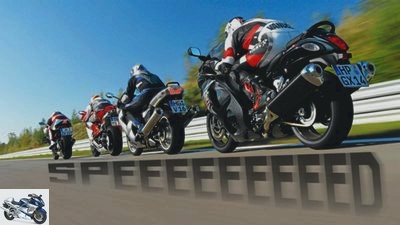
Gargolov
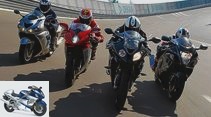

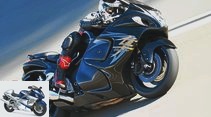

26th photos
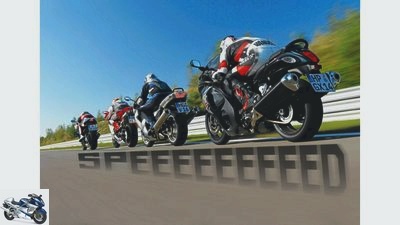
Gargolov
1/26
On the road, everything goes at full throttle and top speed. The fastest bikes out there for the road compete against each other and show who can outrun the others.
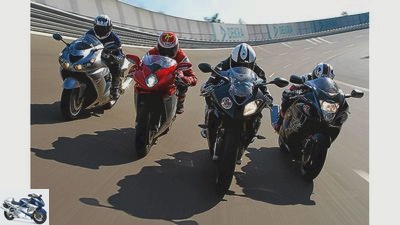
Gargolov
2/26
Since driving on public roads is not an alternative for safety reasons, MOTORRAD is switching to the high-speed oval in Lusatia.
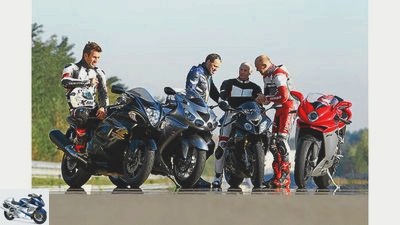
Gargolov
3/26
The BMW S 1000 RR, MV Agusta F4 1000, Kawasaki ZZR 1400 and the Suzuki Hayabusa 1300 will be at the start.
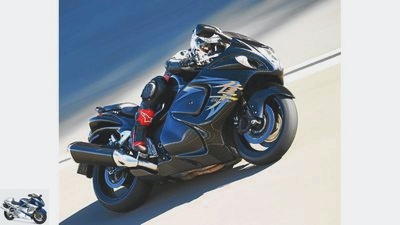
Gargolov
4/26
Suzuki Hayabusa 1300 – Vmax: 298 km / h – 0-280 km / h: 16.8 seconds.
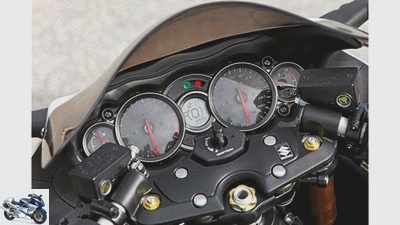
Gargolov
5/26
At full throttle, the unconventional of the organic shapes is very close, traditionally the watch collection in the cockpit: The moving speedometer needle in particular is an impressive statement of acceleration.
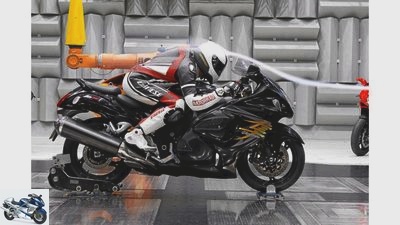
6/26
The aerodynamics can only be seen clearly when testing in the wind tunnel, like the Hayabusa here.
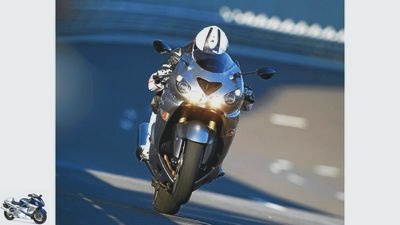
Gargolov
7/26
Also in the comparison test: The Kawasaki ZZR 1400 – Vmax: 299 km / h – 0-280 km / h: 18.7 seconds.
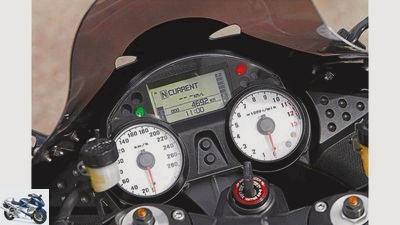
Gargolov
8/26
Clearly laid out and clearly structured: Even in the ZZR cockpit, the top is 280 km / h, but the needle moves all the way to the stop.
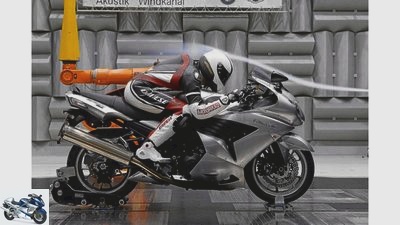
9/26
Here you can see the exemplary wind protection of the Kawasaki.
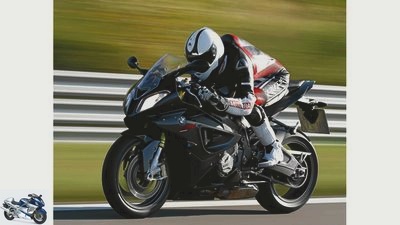
Gargolov
10/26
The BMW S 1000 RR – Vmax: 305 km / h – 0-280 km / h: 14.8 km / h.
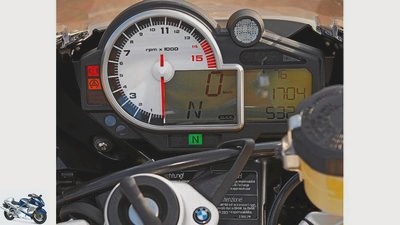
Gargolov
11/26
The engine turns easily up to 14,000 rpm.
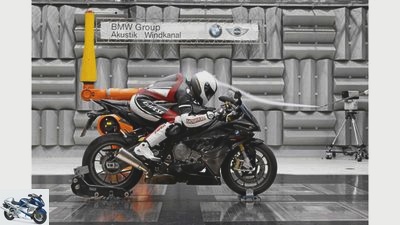
12/26
Powerful, compact: the S 1000 RR is a model athlete, its most distinguished characteristic is aerodynamics that are not impressive.
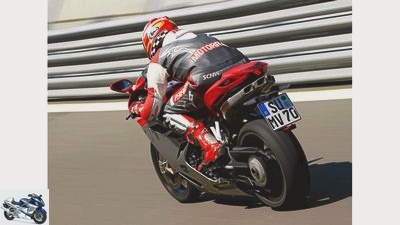
Gargolov
13/26
The noble: MV Agusta F4 1000 – Vmax: 303 km / h – 0-280 km / h: 17.3 seconds.

Gargolov
14/26
The cockpit is a mix of information and design, but confusing.
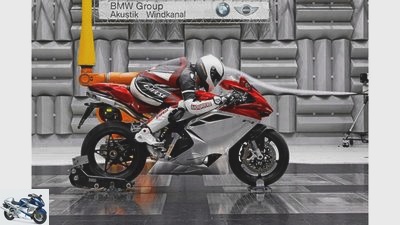
15/26
Classy and fast: You can see the downforce on the front wheel of the F4 in the wind tunnel, as does the petite stature.
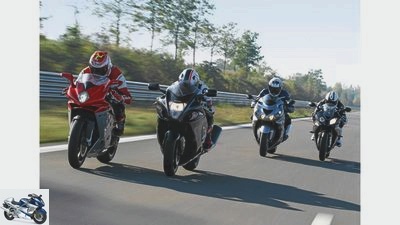
Gargolov
16/26
Lots of power, lots of full throttle with BMW, Kawasaki, MV Agusta and Suzuki.
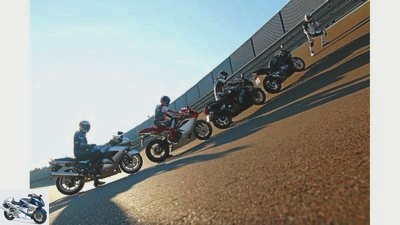
Gargolov
17/26
The curves at the end of the straight are not called steep curves for nothing. The inner radius is 160 meters and the gradient at the top is almost 45 degrees.
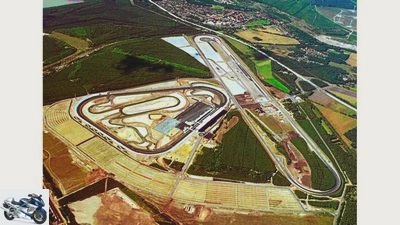
18/26
The test track (right) with the two banked curves. On the left the Lausitzring during construction work.
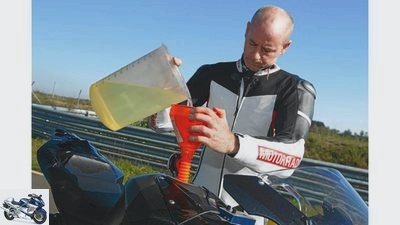
Gargolov
19/26
A lot of full throttle, a lot of fuel consumption: of course only from the fine Super Plus.
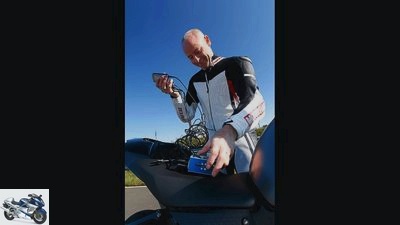
Gargolov
20/26
Everything recorded: if you want to know a lot, you have to measure a lot. And save.
And evaluate.

Gargolov
21/26
Part of the Tellert data logger.
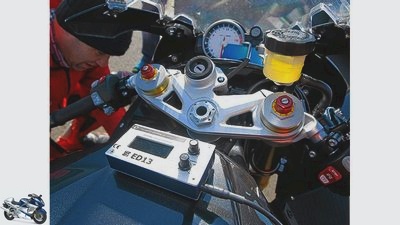
Gargolov
22/26
The other part of the incorruptible Tellert data logger.

23/26
The elaborate insulation shows that this is usually the case
Noise measurements goes. The robot arm then guides the microphone.

24/26
In the dark you can see the air flow in the wind tunnel even more clearly.
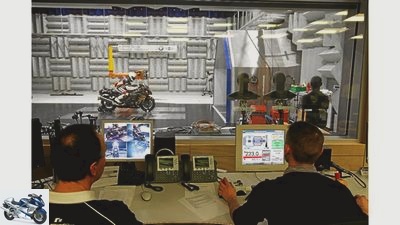
25/26
Still life with a storm: you can’t see a 250 km / h headwind.
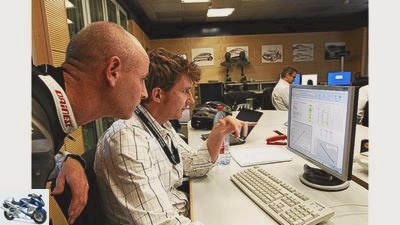
26/26
Anyone who sows a storm will harvest data: BMW professionals and MOTORRAD man Schwers evaluating the measured values.
Comparison test: sport bikes versus speed bikes
The fastest motorcycles in the test
Born to fly: Speed bikes like the Suzuki Hayabusa or the Kawasaki ZZR 1400 make the motorway duel their passion. But even the strong athletes group is at home in the highest speed regions. A comparison on the full throttle front.
Rasthof Wurzburg, sometime in the spring of 1999. A Suzuki Hayabusa drives up, the driver jumps out of the saddle, refuel without removing the helmet and sprints to the cash register. He’s obviously in a hurry. And yet the refueling stop takes forever, because the cashier won’t let him go. Is simply over the moon in view of the idiosyncratic new 175 HP thunderbird. "Hey man, I know you from TV. This is the device that Toni Mang used to travel with. 300, dude, madness. How does that feel? You already drove?"
Ja, how did it feel? Phenomenal! Back then it was simply overwhelming when the speedometer needle reached the 300 mark and happily marched on. A completely unknown world. If things went well and the way was clear, the limit of this new orbit was 340 km / h according to the speedometer, which then corresponded to a real 300 km / h. Just as a reminder: at that time a Honda Fireblade only swung up to 258 km / h and even the benchmark-setting Yamaha R1 with 150 hp did not go beyond 265 km / h. A class difference!
Buy complete article
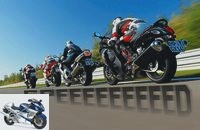
Comparison test: sport bikes versus speed bikes
The fastest motorcycles in the test
S 1000 RR opposite. And the also not weak 177 PS of the fat Kawasaki ZZR 1400 are of course topped on the test bench by the 178 PS of the slim MV Agusta F4.
In other words: A Hayabusa had a measured liter output of 135 HP / L in 1999, today it is 140. That is just five HP more, while the liter output from the 1999 R1 (152 HP / L) to the S 1000 RR has increased by almost 50 PS increased.
Gargolov
Suzuki Hayabusa 1300 – Vmax: 298 km / h – 0-280 km / h: 16.8 seconds.
But: is that enough to replace the old speed queens? What is really fast up there, at the very end of the flagpole? Is it still the relaxed power from ample displacement, combined with high-speed aerodynamics? Or extreme speeds, consistent lightweight construction and a petite stature?
MOTORRAD wanted to know exactly, went on the DEKRA high-speed course at the Lausitzring and in the BMW wind tunnel on test drives and research into the causes. First stop: the 5.8 kilometer so-called motorway circuit right next to Germany’s only oval circuit far in the east of the republic. Because measurements in these speed regions can only be carried out safely on a closed route.
It’s a sunny, almost windless morning in Lusatia, the cold air promises an optimal oxygen supply to the greedy engines, the recording is installed, the drivers tremble in the thin leather towards the 300 km / h experience. Two straights, each 2.3 kilometers long and 12 meters wide, bounded by two mighty steep curves with an inner radius of 160 meters – this should be the setting for a special kind of high-speed festival.
Unfortunately, one thing is clear from the start. Both the Hayabusa and the ZZR 1400 struggle with a handicap in terms of absolute top speed. "Voluntary self-restraint" is the keyword with which motorcycle manufacturers voluntarily limited the speed of their bolides to 299 km / h in the face of threatening legislative restrictions (the Hayabusa was not entirely unaffected).
The Suzuki, like the Kawa, has to live with a speed limit in sixth gear and an official speed specification of 295 km / h or 298 km / h (Kawasaki). MV Agusta, on the other hand, has always refused this voluntary agreement and instead promises a tight 305 km / h. At BMW, too, there was no need for artificial limitation, after all, the S 1000 RR leaves it at 299 km / h according to the vehicle documents.
Gargolov
Also in the comparison test: The Kawasaki ZZR 1400 – Vmax: 299 km / h – 0-280 km / h: 18.7 seconds.
That would answer the question of who is the fastest in the country on paper, right? Probably not, because paper has always been patient in this regard. Are these details correct? And if so, what is the path to the speed summit like? After all, life at the speed limit with these powerhouses in public road traffic is a rarity even in second or third gear. In fifth and sixth gear it is mostly a very, very short episode.
Yes, even the classic acceleration discipline, the sprint from zero to 100 km / h, is done in such a short time that there is neither time to breathe nor to change gears. A glance at the stopwatch, however, shows that simple equations have no validity in this complex matter with many unknowns. Much power times little weight equals top acceleration? Not correct! If there is enough strength anyway, other factors become more important. Above all, the 38 to 55 millimeters more wheelbase (see technical data), but also the factor "Weight" himself. The pounds prove to be a considerable advantage in the difficult balancing act between wide open double flaps and rising front wheel. The result: It is not the strong athletes who weigh around 210 kilograms that pass the 100 km / h mark first, but the 260-kilogram bolides. Simultaneously after 2.9 seconds. Only two or three tenths of a second later does the athlete fraction follow.
Anyone for whom these values are too abstract should imagine the following scenario: A red traffic light in the middle of a German country road that leads straight towards the horizon. On the jump, the four candidates crouch next to each other, first gear has long been engaged, the clutch lurks impatiently just before the point of engagement, the crankshaft rotates at a considerable speed that is barely compatible with the clutch. At "yellow" the clutches engage with great feeling, the fat rear tires whimper for grip, while the riders’ upper bodies brace themselves with all their might against the centrifugal forces that occur, their feet look for a grip on the notches and their hands claw the ends of the handlebars. If all of this works optimally, after just 40 meters (with the two thicknesses) or 42 (BMW) or 43 meters (MV): 100 km / h!
Comparison: Speedbikes vs. Sportbikes – Part 2
Gargolov
The curves at the end of the straight are not called steep curves for nothing. The inner radius is 160 meters, the gradient at the top is almost 45 degrees.
After 40 meters! That’s not even the width of a soccer field or the length of an average indoor pool. For the high-speed course in Lusatia, where the entrance to the track and the paddock (see photo above) is about halfway down the straight, it’s practically nothing. There are still around 1100 meters of pure acceleration ahead of us before we start the steep curve.
But it is already clear: The provocative serenity with which the speed bikes push is alien to the athlete group. And it will remain beyond this brand. Anyone who has ever driven a lush, V8-powered S-Class in comparison with a 911 Porsche knows what is meant. Both can quickly, no question about it. But it feels like they are worlds apart.
This is not only due to the weight and dimensions, the significantly more compact, front-wheel-oriented seating position on the athletes also contributes to the tension. And of course the background noise. It makes a world of difference whether a 1000 with a minimum stroke (not even five centimeters on the BMW) is screeching along the absolute limit of its mechanical strength or an almost 1400 from the depths of its crankcase apparently squeezing buckets of torque from the depths of its crankcase.
But be careful! This effortless game doesn’t have to go on so effortlessly. On the next stage – the sprint to 200 km / h – the world could look a little different. Simply because the biggest shortcoming of the sports ace, the dynamic axle load distribution, has less of an impact with every meter driven.
Gargolov
The BMW S 1000 RR – Vmax: 305 km / h – 0-280 km / h: 14.8 km / h.
Before any misunderstandings arise: Even beyond 100 km / h, the front wheels of the light 1000 series cautiously strive towards the sky. No wonder, because the racing-geared BMW in particular is in first gear up to 147 km / h. The key question, however, is how and when the two factors "light weight" and "good aerodynamics" exert their influence, or whether the third factor "power" in the upper speed range everything decides.
This question (as well as that of the better draft, see measurements) is initially answered quickly in favor of BMW. Meter by meter she puts it between itself and the competition, while behind it the MV Agusta keeps the Hayabusa at a distance with a little effort.
In numbers: The S 1000 RR reaches 200 km / h after an unbelievable 6.9 seconds or 209 meters, so it only needs 3.8 seconds or 166 meters from 100 to 200 km / h. Second place on this section is occupied by the MV (four seconds or 171 meters), who nevertheless cannot pull away from the Hayabusa because she carries her starting handicap with her. In total, it takes 7.3 seconds to reach the 200 mark, while the Hayabusa is a tenth of a second earlier and the Kawasaki, still right at the front in the sprint to 100 km / h, is now clearly behind with 7.6 seconds.
The conclusion: In this speed range, weight plays a more decisive role than sophisticated aerodynamics, and those who are not ahead in terms of performance have a hard time. But there are also other, decisive features that should not be underestimated in the sprint test. We are talking about the automatic gearshift of the S 1000 RR, which makes it possible to change gears with almost no interruption in tractive power – and, by the way, eliminates harsh load changes that have a noticeable effect on driving stability. Such a device would of course also be excellent for speed bikes, which are exclusively dedicated to fast and solid progress. Compared to the S 1000 RR, the ZZR quickly loses 0.3 seconds with a single shift. A short period of time, of course. Which, however, is reflected in more and more distances with increasing speed. At 247 km / h, for example, when changing from gear four to five, these 0.3 seconds of missing propulsion mean a loss of 20 meters.
Gargolov
The noble: MV Agusta F4 1000 – Vmax: 303 km / h – 0-280 km / h: 17.3 seconds.
If you want to feel what forces are at work here – please take a seat. The strongest volcano rages on the tightly cut BMW, pulling at every point of attack. Nevertheless, the Munich-based woman manages something that the speed bikes in particular are a bit away from despite their more expansive fairings. It sprints from 200 to 250 km / h in 3.5 seconds faster than from 100 to 200 km / h (3.8 seconds).
After 10.4 seconds, 250 km / h are reached from a standing start. Or after 426 meters. These are dimensions normally reserved for cruise missiles. Dimensions that none of the others and hardly anyone else can go with on public roads. And again it is the MV, which is most likely to follow with 11.3 seconds, while the Hayabusa and the ZZR 1400 make it to the low-down driver as the sports group, with 11.8 and 12.8 seconds in the race for the blue However, the band kept falling behind.
A preliminary decision? At least one trend, because the lead that BMW has gained is considerable. And the other measured values once again show that the influence of the aerodynamic differences, at least in the case of fully faired motorcycles, as in this field, is far less than that of performance and weight. With a time of 4.4 seconds (250-280 km / h) and a total time of 14.8 seconds, the BMW sprints all of them again, while the signs are once again in the already tight race between the MV Agusta F4 and the Suzuki Hayabusa move. It is probably the combination of a little more power and the slightly better drag coefficient that makes the difference here. In any case, the Suzuki pulls past again in the last few meters, takes the MV off a second and reaches the 280 mark as second, but with a respectable margin of two seconds on the BMW. MV (17.3 seconds) followed on the places, followed by the ZZR 1400 with 18.5 seconds.
So is the whole aerodynamic fuss of the speed bikes a questionable marketing gimmick after all, or is it the means to an end when it comes to the last, image-laden km / h? It is a shame that even the lap-long full throttle club on the DEKRA test track cannot provide any information about this, because the Hayabusa and the ZZR 1400 take their self-restraint seriously. At 298 km / h (Suzuki) and 299 km / h (Kawa) it is over, while the S 1000 RR and the F4 are allowed to mobilize their last power and speed reserves and only brush their sails at 305 and 303 km / h respectively.
Gargolov
Concentrated power: Even on the straights, the BMW S 1000 RR and MV Agusta F4 compete with the Suzuki Hayabusa and the Kawasaki ZZR 1400
But what if? The collection of formulas has to be found where the measuring process reaches its limits. FVR = FL + FR is the calculation basis for the achievable maximum speed. Or, more understandably, the air resistance that increases as the square of the speed (see "In the wind tunnel") and the almost constant rolling resistance must be exceeded by the propulsive power during acceleration, at least equalized at top speed.
For this test field, this means: In relation to their performance on the rear wheel, the BMW and Suzuki would under ideal conditions (the BMW with a slightly longer gear ratio, the Suzuki without limiter) would have a top speed of 312 km / h, the Kawasaki would be 307 and the MV 305 km / h. h reach. That it wasn’t quite enough for that in Lusatia – sponge about it. It was that fast enough.
You can twist and turn it however you want: Pure speed bikes like the Hayabusa or the ZZR 1400 have forfeited their sole claim to the crown when it is all about speed. Today’s athletes can do just as well or better. However, those who appreciate the serenity with which the displacement giants push the engine out of the speed limit or burn straight ahead on the autobahn are welcome to climb up.
Conclusion: And the fastest are the super athletes
You can twist and turn it however you want: Pure speed bikes like the Hayabusa or the ZZR 1400 have forfeited their sole claim to the crown when it is all about speed. Today’s athletes can do that just as well or better. However, those who appreciate the serenity with which the displacement giants push the engine out of the speed limit or burn straight ahead on the autobahn are welcome to climb up.
BMW S 1000 RR
Powerful, compact: the S 1000 RR is a model athlete, its most distinguished characteristic is aerodynamics that are not impressive.
| engine | design type | Four-cylinder, four-stroke in-line engine |
| Bore x stroke | 80.0 x 49.7 mm | Displacement | 999 cm3 |
| power | 142.0 kW (193 hp) at 13,000 rpm | Torque | 111 Nm at 9750 rpm |
| landing gear | |
| frame | Bridge frame made of aluminum | fork | Upside-down fork, Ø 46 mm |
| Brakes v / h | Ø 320 mm / Ø 220 mm | tires | 120/70 ZR 17; 190/55 ZR 17 |
| Tires | Metzeler Racetec K3 Interact | mass and weight | wheelbase | 1432 mm |
| Suspension travel v / h | 120/130 mm | Weight with full tank 1 | 208 kg |
| price | 17586 euros |
Kawasaki ZZR 1400
Powerful, compact: the S 1000 RR is a model athlete, its most distinguished characteristic is aerodynamics that are not impressive.
| engine | design type | Four-cylinder, four-stroke in-line engine |
| Bore x stroke | 84.0 x 61.0 mm | Displacement | 1352 cm3 |
| power | 140.0 kW (190 hp) at 9500 rpm | Torque | 154 Nm at 7500 rpm |
| landing gear | |
| frame | Aluminum monocoque | fork | Upside-down fork, Ø 43 mm |
| Brakes v / h | Ø 310 mm / Ø 250 mm | tires | 120/70 ZR 17; 190/50 ZR 17 |
| Tires | Bridgestone BT 014 front “SL”, rear “L” | mass and weight | wheelbase | 1460 mm |
| Suspension travel v / h | 117/122 mm | Weight with full tank 1 | 260 kg |
| price | 15075 euros |
MV Agusta F4 1000
Powerful, compact: the S 1000 RR is a model athlete, its most distinguished characteristic is aerodynamics that are not impressive.
| engine | design type | Four-cylinder, four-stroke in-line engine |
| Bore x stroke | 76.0 x 55.0 mm | Displacement | 998 cm3 |
| power | 137.0 kW (186 hp) at 12900 rpm | Torque | 114 Nm at 9500 rpm |
| landing gear | |
| frame | Steel tubular frame, engine is load-bearing | fork | Upside-down fork, Ø 50 mm |
| Brakes v / h | Ø 320 mm / Ø 210 mm | tires | 120/70 ZR 17; 190/55 ZR 17 |
| Tires | Pirelli Diablo Supercorsa SP | mass and weight | wheelbase | 1430 mm |
| Suspension travel v / h | 120/120 mm | Weight with full tank 1 | 214 kg |
| price | 18,750 euros |
Suzuki Hayabusa 1300
The aerodynamics can only be seen clearly when testing in the wind tunnel, like the Hayabusa here.
| engine | design type | Four-cylinder, four-stroke in-line engine |
| Bore x stroke | 81.0 x 65.0 mm | Displacement | 1340 cm3 |
| power | 145.0 kW (197 hp) at 9500 rpm | Torque | 155 Nm at 7200 rpm |
| landing gear | |
| frame | Bridge frame made of aluminum | fork | Upside-down fork, Ø 43 mm |
| Brakes v / h | Ø 310 mm / Ø 260 mm | tires | 120/70 ZR 17; 190/50 ZR 17 |
| Tires | Bridgestone BT 015 “M” | mass and weight | wheelbase | 1485 mm |
| Suspension travel v / h | 120/140 mm | Weight with full tank 1 | 264 kg |
| price | 14780 euros |
MOTORCYCLE measurements
Drawing: archive
The diagrams of the speed bikes: Left: power on the crankshaft – Reckts: power on the rear wheel.
If you only look at the power at the crankshaft, you can get a wrong impression in this case – namely with engines with such different cubic capacities. Because of course the powerful units from Hayabusa and ZZR 1400 are miles above the 1000s, especially in terms of torque. Things look a little different when you look at the performance via the speed on the rear wheel. There, for example, the BMW S 1000 RR comes up to a small trailer between 100 and 150 km / h almost at Hayabusa level and is clearly above 250 km / h above. If you also take into account the approximately 50 kilograms extra weight of the Suzuki, the superior performance of the Munich woman is absolutely plausible.
Just like the fact that the Hayabusa of the ZZR 1400 leaves the ZZR 1400 in all respects. From around 6500 rpm or 170 km / h, the Suzuki curve is almost always and clearly above the Kawasaki curve, while the F4 of the S 1000 RR can never hold a candle.
BMW S 1000 RR
Gargolov
BMW S 1000 RR
| Air resistance Cw x A | Motorcycle (m2) | 0.315 |
| with driver lying down (m2) | 0.324 | with seated driver (m2) | 0.455 |
| Calculated power requirement on the rear wheel / crankshaft with the rider lying down | |
| at 200 km / h (PS) | 49/56 | at 300 km / h (PS) | 159/176 |
| at 350 km / h (PS) | 251/276 | Weights | Weight without driver (kg) | 208 |
| Weight distribution front / rear (kg) | 108/100 | Weight with driver (kg) | 286 |
| Weight distribution front / rear (kg) | 138/148 | Front lift at 300 km / h | with driver lying down (N) | 663 |
| with seated driver (N) | 954 | Rear downforce at 300 km / h | with driver lying down (N) | 434 |
| with seated driver (N) | 835 | Weight force with driver static | front / back (N) | 1354/1452 |
| Resulting weight force at 300 km / h | |
| front / back (N) | 691/1886 | corresponds in kg | 70/192 |
| Top speed | |
| Vmax measured (km / h) | 305 | at speed (rpm) | 14000 |
| Vmax calculated (km / h) | 312 | Theoretically possible speed | at maximum speed (km / h at rpm) | 308/14200 |
| at 200 PS on the crankshaft (km / h) | 314 | Draft | 150–200 km / h (sec) / (m) | 4.2 / 203 |
| 200–250 km / h (sec) / (m) | 4.7 / 294 | acceleration | 0–100 km / h (sec) / (m) | 3.1 / 43 |
| 0–200 km / h (sec) / (m) | 6.9 / 209 | 0–250 km / h (sec) / (m) | 10.4 / 426 |
| 0–280 km / h (sec) / (m) | 14.8 / 750 | Measured performance | Rear wheel power (PS) | 183.5 |
| at speed (km / h) | 284 | Power at the crankshaft (PS) | 198.3 |
| at speed (rpm) | 13100 |
Kawasaki ZZR 1400
Gargolov
Kawasaki ZZR 1400
| Air resistance Cw x A | Motorcycle (m2) | 0.321 |
| with driver lying down (m2) | 0.306 | with seated driver (m2) | 0.372 |
| Calculated power requirement on the rear wheel / crankshaft with the rider lying down | |
| at 200 km / h (PS) | 47/54 | at 300 km / h (PS) | 152/168 |
| at 350 km / h (PS) | 238/263 | Weights | Weight without driver (kg) | 262 |
| Weight distribution front / rear (kg) | 130/132 | Weight with driver (kg) | 340 |
| Weight distribution front / rear (kg) | 161/179 | Front lift at 300 km / h | with driver lying down (N) | 497 |
| with seated driver (N) | 623 | Rear downforce at 300 km / h | with driver lying down (N) | 398 |
| with seated driver (N) | 501 | Weight force with driver static | front / back (N) | 1579/1756 |
| Resulting weight force at 300 km / h | |
| front / rear (N) | 1082/2154 | corresponds in kg | 110/220 |
| Top speed | |
| Vmax measured (km / h) | 299 * | at speed (rpm) | 10300 |
| Vmax calculated (km / h) | 307 | Theoretically possible speed | at maximum speed (km / h at rpm) | 324/11000 |
| at 200 PS on the crankshaft (km / h) | 319 | Draft | 150–200 km / h (sec) / (m) | 4.6 / 223 |
| 200–250 km / h (sec) / (m) | 5.7 / 361 | acceleration | 0–100 km / h (sec) / (m) | 2.9 / 40 |
| 0–200 km / h (sec) / (m) | 7.6 / 241 | 0–250 km / h (sec) / (m) | 12.5 / 548 |
| 0–280 km / h (sec) / (m) | 18.5 / 991 | Measured performance | Rear wheel power (PS) | 166.9 |
| at speed (km / h) | 274 | Power at the crankshaft (PS) | 179.9 |
| at speed (rpm) | 9800 |
MV Agusta F4 1000
Gargolov
MV Agusta F4 1000
| Air resistance Cw x A | Motorcycle (m2) | 0.286 |
| with driver lying down (m2) | 0.314 | with seated driver (m2) | 0.42 |
| Calculated power requirement on the rear wheel / crankshaft with the rider lying down | |
| at 200 km / h (PS) | 48/54 | at 300 km / h (PS) | 155/170 |
| at 350 km / h (PS) | 244/266 | Weights | Weight without driver (kg) | 214 |
| Weight distribution front / rear (kg) | 110/104 | Weight with driver (kg) | 292 |
| Weight distribution front / rear (kg) | 142/150 | Front lift at 300 km / h | with driver lying down (N) | 442 |
| with seated driver (N) | 720 | Rear downforce at 300 km / h | with driver lying down (N) | 371 |
| with seated driver (N) | 685 | Weight force with driver static | front / rear (N) | 1393/1472 |
| Resulting weight force at 300 km / h | |
| front / rear (N) | 951/1843 | corresponds in kg | 97/188 |
| Top speed | |
| Vmax measured (km / h) | 303 | at speed (rpm) | 13500 |
| Vmax calculated (km / h) | 305 | Theoretically possible speed | at maximum speed (km / h at rpm) | 304/13500 |
| at 200 PS on the crankshaft (km / h) | 318 | Draft | 150–200 km / h (sec) / (m) | 4.9 / 236 |
| 200–250 km / h (sec) / (m) | 5.5 / 349 | acceleration | 0–100 km / h (sec) / (m) | 3.3 / 44 |
| 0–200 km / h (sec) / (m) | 7.3 / 215 | 0–250 km / h (sec) / (m) | 11.3 / 473 |
| 0–280 km / h (sec) / (m) | 17.3 / 916 | Measured performance | Rear wheel power (PS) | 164.8 |
| at speed (km / h) | 274 | Power at the crankshaft (PS) | 177.5 |
| at speed (rpm) | 12300 |
Suzuki Hayabusa 1300
Gargolov
Suzuki Hayabusa 1300
| Air resistance Cw x A | Motorcycle (m2) | 0.315 |
| with driver lying down (m2) | 0.303 | with seated driver (m2) | 0.399 |
| Calculated power requirement on the rear wheel / crankshaft with the rider lying down | |
| at 200 km / h (PS) | 47/53 | at 300 km / h (PS) | 151/167 |
| at 350 km / h (PS) | 236/261 | Weights | Weight without driver (kg) | 266 |
| Weight distribution front / rear (kg) | 132/134 | Weight with driver (kg) | 344 |
| Weight distribution front / rear (kg) | 166/178 | Front lift at 300 km / h | with driver lying down (N) | 568 |
| with seated driver (N) | 742 | Rear downforce at 300 km / h | with driver lying down (N) | 351 |
| with seated driver (N) | 521 | Weight force with driver static | front / rear (N) | 1628/1746 |
| Resulting weight force at 300 km / h | |
| front / rear (N) | 1060/2097 | corresponds in kg | 108/214 |
| Top speed | |
| Vmax measured (km / h) | 298 * | at speed (rpm) | 10400 |
| Vmax calculated (km / h) | 312 | Theoretically possible speed | at maximum speed (km / h at rpm) | 315/11000 |
| at 200 PS on the crankshaft (km / h) | 320 | Draft | 150–200 km / h (sec) / (m) | 4.2 / 203 |
| 200–250 km / h (sec) / (m) | 5.1 / 318 | acceleration | 0–100 km / h (sec) / (m) | 2.9 / 40 |
| 0–200 km / h (sec) / (m) | 7.2 / 224 | 0–250 km / h (sec) / (m) | 11.8 / 515 |
| 0–280 km / h (sec) / (m) | 16.8 / 893 | Measured performance | Rear wheel power (PS) | 172.9 |
| at speed (km / h) | 267 | Power at the crankshaft (PS) | 187.3 |
| at speed (rpm) | 9900 |
Theory and practice – in the wind tunnel
Still life with a storm: you can’t see a 250 km / h headwind.
How big are the aerodynamic differences between fat speed bikes and slim super athletes? And what do they mean?
The BMW acoustic wind tunnel in Hanauer Strasse cannot be seen from the outside of what is inside. In the 43 meter long and 15 meter high building there is usually a rough wind, generated by a fan with 14 adjustable blades and 21 guide vanes with a diameter of 5.5 meters. It is powered by a 2638 hp engine and the maximum wind speed is 255 km / h.
A good address when it comes to determining the air resistance of a motorcycle. The drag force results from the drag coefficient (Cw value) of the frontal area (A), the air density (?) And the speed (v) and forms the basis for all further calculations for MOTORCYCLE measurements.
About the facts: First of all, it is astonishing that without a driver, the slippery Hayabusa has the same air resistance as the rugged BMW (0.315). The sensationally low value of the MV (0.286) shows what influence the frontal area has in this measurement, while the ZZR brings up the rear with 0.321. With the driver lying down, however, the picture changes. The Suzuki continues to mark the top (0.303) and – like the Kawa (0.306), by the way – is even cheaper than without a driver, while the MV and even more the BMW fall significantly behind with 0.314 and 0.324 respectively.
This clearly shows that the driver is part of the overall aerodynamic concept on the two big ships, while he is noticeably annoying on the two sportswomen.
The extent to which these values affect driving performance can be calculated. Based on the performance measured on the rear wheel, the S 1000 RR and Hayabusa would have 312 km / h, the F4 305 km / h and the ZZR 1400 307 km / h (excluding all measurement tolerances and environmental influences). And another thought game: If all four motorcycles had exactly 200 hp on the crankshaft, the Hayabusa would be 320 km / h, the Kawa 319, the MV 318 and the BMW 314. For comparison: a naked bike like the XJR 1300 would be included achieve an air resistance of 0.460 at this performance 281 km / h.
But not only the air resistance, but also the lift on the front and rear wheels can be measured here. Exemplary here are the low lift values of the MV, which are reflected in convincing driving stability.
The test track
archive
The test track (right) with the two banked curves. On the left the Lausitzring during construction work.
Anyone who wants to measure speeds of around 300 km / h needs a very special test track.
Of course, an empty freeway would too. If there weren’t any cars, no trucks, no one suddenly left. As a reminder: at 300 km / h you cover a good 83 meters. In the second! That is roughly twice the distance a BMW S 1000 RR needs to accelerate from 0 to 100 km / h. However, since there is not infinite space available even in Lusatia, two curves are needed here as well. In this case two banked curves with an inner radius of 160 meters. Anyone who has ever ridden a rollercoaster can understand what that means. Far up, as close as possible to the guardrail, you stab into the steep wall with what feels like an excess speed of 100 km / h. Arrows razor-sharp past the lane as it presses its head to its chest. Accelerates again, trying to keep your head up. Where’s the exit? Eons pass, the neck muscles become weak. And then, the moment: Suddenly the train tips over to the right, almost 230 should now be on the clock. Counterhold, just don’t go too far. Done the straight. Pure relaxation.
Acting forces
archive
The forces acting when driving.
FL and FR – these are the decisive forces that must be overcome by the propulsive force in order to accelerate the motorcycle. The rolling resistance forces, which are determined by the vehicle weight and the rolling resistance coefficient, are almost constant over the entire speed and are irrelevant at higher speeds. The lift force (FAUF) on the front wheel increases with increasing speed and relieves the load on the front wheel, while driving stability deteriorates at high speed.
Related articles
-
Motorcycles with a lot of horsepower in a comparison test
34 pictures 1/34 The strongest in their class: BMW K 1300 R, MV Agusta F3, Ducati Multistrada 1200 S, Kawasaki ZZR 1400, BMW S 1000 …
-
Comparison test of speed bikes
fact 65 pictures BMW 1/65 driving report in MOTORRAD 16/2004: the new K 1200 S. BMW 2/65 driving report in MOTORRAD 16/2004: the new K 1200 S. BMW 3/65 …
-
Comparison test of naked bikes
Naked bike comparison test 2011: Ducati, Kawasaki and Triumph The triumph of the new Speed Triple content from Triumph strikes back. After this…
-
A comparison test of dream bikes from the PS editors
Markus Jahn 22nd photos markus-jahn.com 1/22 Two power nakeds and two superbikes form a powerful team. Lively romp as a freestyle. markus-jahn.com 2/22…
-
350cc sport enduro bikes from Beta, Husqvarna, KTM and Sherco in a comparison test
Gargolov 22nd photos Gargolov 1/22 350 series enduro bikes in comparison: Beta RR 350 EFI, Husqvarna FE 350, KTM 350 EXC-F and Sherco 300 SEF-R. Gargolov…
-
Reader’s test: the most powerful bikes of all classes
Gargolov MOTORRAD readers as test crew (video) The strongest bikes of all classes MOTORRAD invited six owners of the strongest bikes of all categories to …
-
48 hp motorcycles in a comparison test
Bilski 71 photos Bilski 1/71 Seven 48 hp twins from the manufacturers Honda, Ducati, Suzuki, Harley-Davidson, Kawasaki and BMW were tested. Bilski 2/71…
-
Comparison test of mid-range bikes with full fairing
Gargolov 26 pictures Gargolov 1/26 Kawasaki ER-6f: Inexpensive, compact, light and handy – the powerful parallel twin is fun, the chassis is …
-
Comparison test: Epochal motorcycles
fact 9 pictures fact 1/9 Honda CBR 900 RR Fireblade: Back then and now a nuisance: The idiosyncratic 16-inch front wheel worsens handling with …
-
fact comparison test Big Bikes, BMW K 1200 S, Honda CBR 1100 XX Blackbird, Kawasaki Ninja ZX-12R, Kawasaki ZZR 1400, Suzuki GSX 1300 R Hayabusa Enough is …